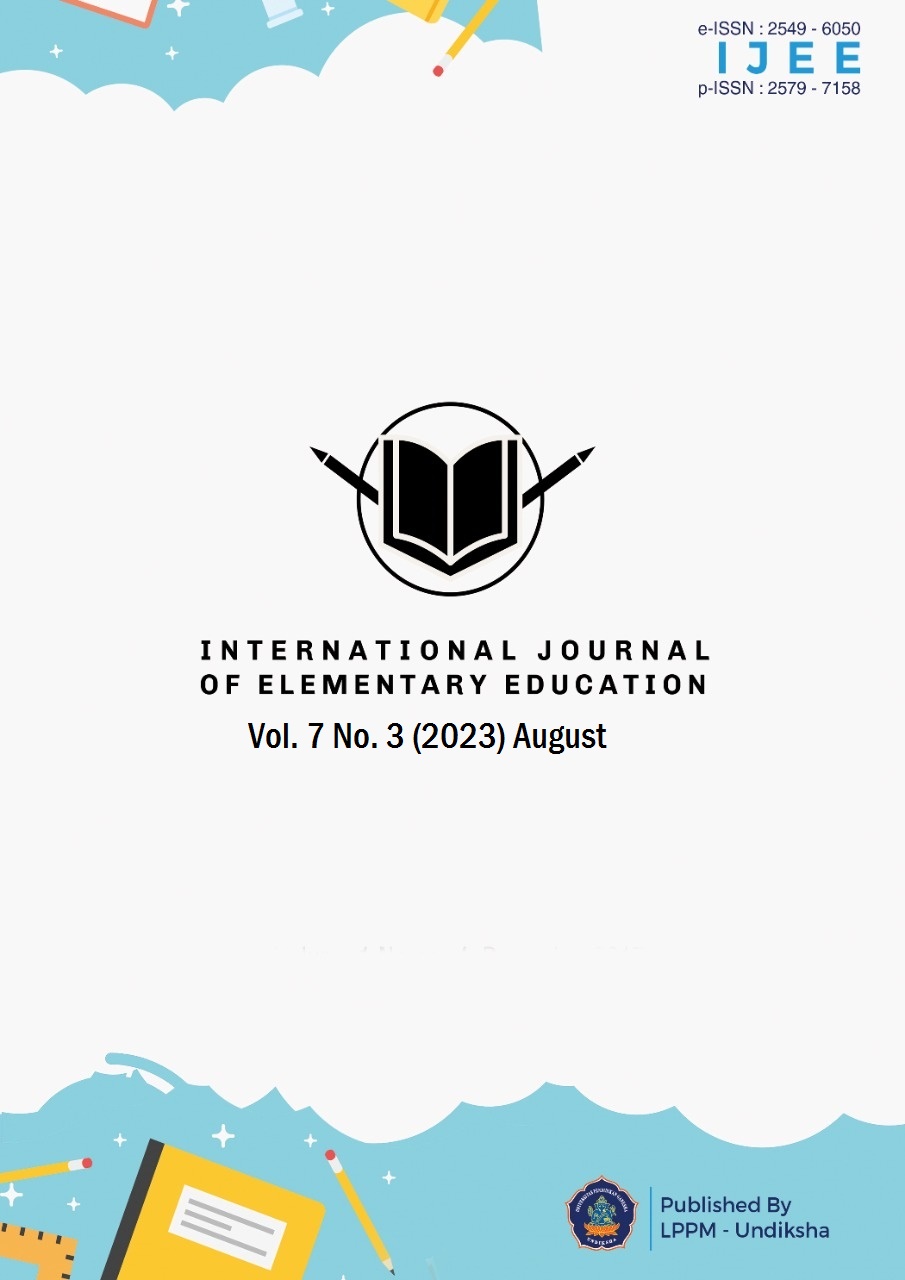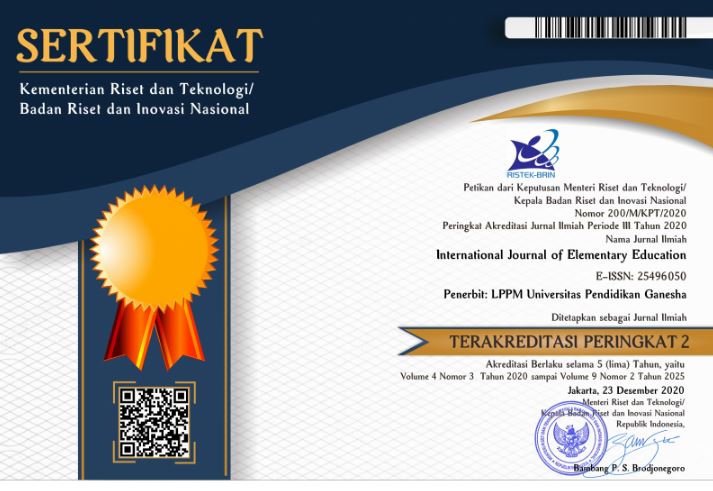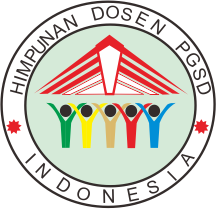Augmented Reality-Oriented Problem-Based Learning in Natural Science Materials
DOI:
https://doi.org/10.23887/ijee.v7i3.60618Keywords:
augmented reality, Problem-Based Learning, ADDIEAbstract
Problems that arise from students' difficulties in participating in the learning process and working on media for a long time make students' abilities low. Student learning outcomes are common because the lack of student knowledge is the main problem in learning. To help improve student learning outcomes can be assisted by using learning media, this study uses augmented reality learning media. This study aims to design problem-based learning based on augmented reality on science material for class V. This research uses a quantitative method. The subjects in this study consisted of 1 media expert, one design expert, and one content expert; three students as individual trials, nine as small group trials, and 23 as field trials. Data collection techniques include qualitative description, quantitative description, and statistical inferential t-test. The results of the study were (1) the design of augmented reality with the ADDIE model stages, (2) the media expert scored 94.4% very good qualification, the design expert test scored 92% very good qualification, the content expert test scored 98.6% qualification very good, individual trials obtained a score of 96.47% very good qualification, group trials obtained a score of 95.57% very good qualifications, (3) based on the effectiveness test it was declared effective, based on the average pretest results with a score of 49.2 and the average posttest results with a score of 84.78. It can be concluded that problem-based learning-oriented augmented reality in science material is feasible.
References
Aditama, P. W., Nyoman Widhi Adnyana, I., & Ayu Ariningsih, K. (2021). Augmented Reality Dalam Multimedia Pembelajaran. Prosiding Seminar Nasional Desain Dan Arsitektur (SENADA), 2, 176–182. https://doi.org/10.31571/saintek.v12i1.5883.
Agus, C. (2020). Cultural-Based Education of Tamansiswa as a Locomotive of Indonesian Education System. In World Sustainability Series (pp. 471–486). https://doi.org/10.1007/978-3-030-15604-6_29. DOI: https://doi.org/10.1007/978-3-030-15604-6_29
Al Hakim, R., Mustika, I., & Yuliani, W. (2021). Validitas Dan Reliabilitas Angket Motivasi Berprestasi. FOKUS (Kajian Bimbingan & Konseling Dalam Pendidikan), 4(4), 263. https://doi.org/10.22460/fokus.v4i4.7249. DOI: https://doi.org/10.22460/fokus.v4i4.7249
Astuti, N. R. W., & Dewi, D. A. (2021). Pentingnya Implementasi Nilai-Nilai Pancasila Dalam Menghadapi Perkembangan IPTEK. EduPsyCouns Journal: Journal of Education, Psychology and Counseling, 3(1), 41–49. https://doi.org/https://ummaspul.e-journal.id/Edupsycouns/article/view/1263.
Blumberg, F. C., & Fisch, S. M. (2013). Introduction: Digital games as a context for cognitive development, learning, and developmental research. New Directions for Child and Adolescent Development, 139, 1–9. https://doi.org/10.1002/cad.20026. DOI: https://doi.org/10.1002/cad.20026
Burhanudin, A. (2017). Pengembangan Media Pembelajaran Augmented Reality Pada Mata Pelajaran Dasar Elektronika Di Smk Hamong Putera 2 Pakem. Pendidikan Teknik Mekatronika, 7(3), 266–274. https://doi.org/10.5281/zenodo.6943518.
Cherly Ana Safira, Agung Setyawan, & Tyasmiarni Citrawati. (2020). Identifikasi Permasalahan Pembelajaran IPA Pada Siswa Kelas III SDN Buluh 3 Socah. Jurnal Pendidikan Mipa, 10(1), 23–29. https://doi.org/10.37630/jpm.v10i1.277. DOI: https://doi.org/10.37630/jpm.v10i1.277
Dewi, N., Murtinugraha, R. E., & Arthur, R. (2018). Pengembangan Media Pembelajaran Interaktif Pada Mata Kuliah Teori Dan Praktik Plambing Di Program Studi S1 Pvkb Unj. Jurnal PenSil, 7(2), 95–104. https://doi.org/10.21009/pensil.7.2.6. DOI: https://doi.org/10.21009/pensil.7.2.6
Egger, J. (2020). Augmented reality in support of intelligent manufacturing – A systematic literature review. In Computers and Industrial Engineering (Vol. 140). https://doi.org/10.1016/j.cie.2019.106195. DOI: https://doi.org/10.1016/j.cie.2019.106195
Fitri, S. F. N. (2021). Problematika Kualitas Pendidikan di Indonesia. Jurnal Pendidikan Tambusai, 5(1), 1617–1620. https://www.jptam.org/index.php/jptam/article/view/1148.
Fitriani Eka, S., Muhsinah, A., & Dedi, K. (2018). Pengembangan Media Pembelajaran IPA menggunakan Augmented Reality (AR) Berbasis Android pada Siswa Kelas III SDN 015 Tarakan. Widyagogik, 6(1), 57–72. http://e-journal.hamzanwadi.ac.id/index.php/infotek/article/view/12496.
Hanafi, Y. (2020). Reinforcing public university student’s worship education by developing and implementing mobile-learning management system in the ADDIE instructional design model. International Journal of Interactive Mobile Technologies, 14(2), 215–241. https://doi.org/10.3991/ijim.v14i02.11380. DOI: https://doi.org/10.3991/ijim.v14i02.11380
Hasiru, D., Badu, S. Q., & Uno, H. B. (2021). Media-Media Pembelajaran Efektif dalam Membantu Pembelajaran Matematika Jarak Jauh. Jambura Journal of Mathematics Education, 2(2), 59–69. https://doi.org/10.34312/jmathedu.v2i2.10587. DOI: https://doi.org/10.34312/jmathedu.v2i2.10587
Jusuf, W. M., Latjompoh, M., & Ahmad, J. (2022). Validitas Perangkat Pembelajaran Berorientasi Model Pembelajaran Inkuiri Pada Materi Struktur Dan Fungsi Jaringan Pada Tumbuhan Untuk Melatih Kemampuan Berpikir Kreatif Peserta Didik. Jambura Edu Biosfer Journal, 4(1), 30–36. https://doi.org/10.34312/jebj.v4i1.14316. DOI: https://doi.org/10.34312/jebj.v4i1.14316
Kurnia, T. D., Lati, C., Fauziah, H., & Trihanton, A. (2019). Model ADDIE Untuk Pengembangan Bahan Ajar Berbasis Kemampuan Pemecahan Masalah Berbantuan 3D. Seminar Nasional Pendidikan Matematika, 1(1), 516–525. http://www.fkip-unswagati.ac.id/ejournal/index.php/snpm/article/view/844.
Marzal, J. (2020). The use of ADDIE model to re-create academic information systems to improve user satisfaction. In Journal of Physics: Conference Series (Vol. 1567, Issue 3). https://doi.org/10.1088/1742-6596/1567/3/032033. DOI: https://doi.org/10.1088/1742-6596/1567/3/032033
Mie, E., Kuliah, M., & Dan, K. (2018). Addie Sebagai Model Pengembangan Media Instruksional. Jurnal Pendidikan Teknologi Dan Kejuruan, 15(2), 277–286. https://j-cup.org/index.php/cendekia/article/view/1362.
Muhaimin. (2020). Science teachers’ integration of digital resources in education: A survey in rural areas of one Indonesian province. Heliyon, 6(8). https://doi.org/10.1016/j.heliyon.2020.e04631. DOI: https://doi.org/10.1016/j.heliyon.2020.e04631
Nida, S. (2020). A survey of Indonesian science teachers’ experience and perceptions toward socio-scientific issues-based science education. Education Sciences, 10(2). https://doi.org/10.3390/educsci10020039. DOI: https://doi.org/10.3390/educsci10020039
Nistrina, K. (2021). Penerapan Augmented Reality dalam Media Pembelajaran. Jurnal Sistem Informasi, J-SIKA, 03(01), 1–6. http://e-journal.hamzanwadi.ac.id/index.php/infotek/article/view/16830.
Nurrita. (2018). Media Pembelajaran dan Hasil Belajar Siswa. Misykat, 03, 171–187. https://lmsspada.kemdikbud.go.id/pluginfile.php/423559/mod_resource/content/2/Bahan bacaan.pdf. DOI: https://doi.org/10.33511/misykat.v3n1.171
Octavyanti, N. P. L., & Wulandari, I. G. A. A. (2021). Pengembangan Video Pembelajaran Berbasis Pendekatan Kontekstual Pada Mata Pelajaran Matematika Kelas IV SD. Jurnal Edutech Undiksha, 9(1), 66–74. https://doi.org/10.23887/jeu.v9i1.32223. DOI: https://doi.org/10.23887/jeu.v9i1.32223
Petrov, P. D. (2020). The Effect of augmented reality on students’ learning performance in stem education. Information (Switzerland), 11(4). https://doi.org/10.3390/INFO11040209. DOI: https://doi.org/10.3390/info11040209
Prananda, G., Saputra, R., & Ricky, Z. (2020). Meningkatkan Hasil Belajar Menggunakan Media Lagu Anak Dalam Pembelajaran Ipa Sekolah Dasar. Jurnal IKA PGSD (Ikatan Alumni PGSD) UNARS, 8(2), 304. https://doi.org/10.36841/pgsdunars.v8i2.830. DOI: https://doi.org/10.36841/pgsdunars.v8i2.830
Putra, E. F., & Suharjana, S. (2018). Model senam lansia untuk kebugaran jasmani dan fungsi otak. Jurnal Keolahragaan, 6(2), 120–129. https://doi.org/10.21831/jk.v0i0.20626. DOI: https://doi.org/10.21831/jk.v0i0.20626
Sahin, D., & Yilmaz, R. M. (2020). The effect of Augmented Reality Technology on middle school students’ achievements and attitudes towards science education. Computers and Education, 144, 103710. https://doi.org/10.1016/j.compedu.2019.103710. DOI: https://doi.org/10.1016/j.compedu.2019.103710
Supriono, N., & Rozi, F. (2018). Pengembangan Media Pembelajaran Bentuk Molekul Kimia Menggunakan Augmented Reality Berbasis Android. JIPI (Jurnal Ilmiah Penelitian Dan Pembelajaran Informatika), 3(1), 53–61. https://doi.org/10.29100/jipi.v3i1.652. DOI: https://doi.org/10.29100/jipi.v3i1.652
Tafonao, T. (2018). Peranan Media Pembelajaran Dalam Meningkatkan Minat Belajar Mahasiswa. Jurnal Komunikasi Pendidikan, 2(2), 103. https://doi.org/10.32585/jkp.v2i2.113. DOI: https://doi.org/10.32585/jkp.v2i2.113
Tahmidaten, L., & Krismanto, W. (2020). Permasalahan Budaya Membaca di Indonesia (Studi Pustaka Tentang Problematika & Solusinya). Scholaria: Jurnal Pendidikan Dan Kebudayaan, 10(1), 22–33. https://doi.org/10.24246/j.js.2020.v10.i1.p22-33. DOI: https://doi.org/10.24246/j.js.2020.v10.i1.p22-33
Tegeh, I. M., & Kirna, I. M. (2013). Pengembangan Bahan Ajar Metode Penelitian Pendidikan dengan ADDIE Model. Jurnal IKA, 11(1), 16. https://doi.org/10.23887/ika.v11i1.1145.
Trisiana, A. (2020). Penguatan Pembelajaran Pendidikan Kewarganegaraan Melalui Digitalisasi Media Pembelajaran. Jurnal Pendidikan Kewarganegaraan, 10(2), 31. https://doi.org/10.20527/kewarganegaraan.v10i2.9304. DOI: https://doi.org/10.20527/kewarganegaraan.v10i2.9304
Tu, J. C. (2021). Basic courses of design major based on the addie model: Shed light on response to social trends and needs. Sustainability (Switzerland), 13(8). https://doi.org/10.3390/su13084414. DOI: https://doi.org/10.3390/su13084414
Whidi Harta, G., Seri Wahyuni, D., & Saindra Santyadiputra, G. (2021). Kepraktisan Media Pembelajaran Augmented Reality Mata Pelajaran Sablon untuk SMK. Kumpulan Artikel Mahasiswa Pendidikan Teknik Informatika (KARMAPATI), 10(2), 182–192. https://doi.org/10.23887/karmapati.v10i2.35648. DOI: https://doi.org/10.23887/karmapati.v10i2.35648
Wibisono, H. A., Situmorang, R., & Solihatin, E. (2020). Pengembangan Video Animasi Tutorial Ujian Tanda Kecakapan Khusus Pramuka Sekolah Dasar. Perspektif Ilmu Pendidikan, 34(2), 125–136. https://doi.org/10.21009/pip.342.7. DOI: https://doi.org/10.21009/PIP.342.7
Widiarti, N. K., Sudarma, I. K., & Tegeh, I. M. (2021). Meningkatkan Hasil Belajar Matematika Kelas V SD Melalui Media Video Pembelajaran. Jurnal Edutech Undiksha, 9(2), 195–205. https://doi.org/10.23887/jeu.v9i2.38376. DOI: https://doi.org/10.23887/jeu.v9i2.38376
Yanto, D. T. P. (2019). Praktikalitas Media Pembelajaran Interaktif pada Proses Pembelajaran Rangkaian Listrik. INVOTEK: Jurnal Inovasi Vokasional Dan Teknologi, 19(1), 75–82. https://doi.org/10.24036/invotek.v19i1.409. DOI: https://doi.org/10.24036/invotek.v19i1.409
Yu, M. (2020). The Chinese version of the Urticaria Control Test and validation of its reliability and validity. Chinese Journal of Dermatology, 53(7), 533–538. https://doi.org/10.35541/cjd.20191190. DOI: https://doi.org/10.35541/cjd.20191190
Zafar, S. (2020). Evaluation of HoloHuman augmented reality application as a novel educational tool in dentistry. European Journal of Dental Education, 24(2), 259–265. https://doi.org/10.1111/eje.12492. DOI: https://doi.org/10.1111/eje.12492
Downloads
Published
How to Cite
Issue
Section
License
Copyright (c) 2023 adi wiraha

This work is licensed under a Creative Commons Attribution-ShareAlike 4.0 International License.
Authors who publish with the International Journal of Elementary Education agree to the following terms:
- Authors retain copyright and grant the journal the right of first publication with the work simultaneously licensed under a Creative Commons Attribution License (CC BY-SA 4.0) that allows others to share the work with an acknowledgment of the work's authorship and initial publication in this journal.
- Authors are able to enter into separate, additional contractual arrangements for the non-exclusive distribution of the journal's published version of the work (e.g., post it to an institutional repository or publish it in a book), with an acknowledgment of its initial publication in this journal.
- Authors are permitted and encouraged to post their work online (e.g., in institutional repositories or on their website) prior to and during the submission process, as it can lead to productive exchanges, as well as earlier and greater citation of published work. (See The Effect of Open Access)









